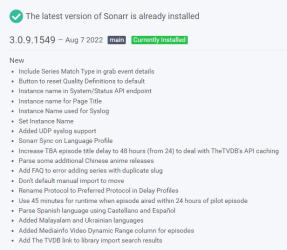
- #INSTALL SONARR RASPBERRY PI 2 HOW TO#
- #INSTALL SONARR RASPBERRY PI 2 APK#
- #INSTALL SONARR RASPBERRY PI 2 UPDATE#
- #INSTALL SONARR RASPBERRY PI 2 DOWNLOAD#
Pull an image and run or create the container based on that image, adding some options in the command.These options persist on restart. Reload mounts and confirm that the Alpine host has access to the shares: sudo mount -a Sudo chown -R dockeras:docker /mnt/synomovies Make them accessible by the docker user: sudo chown -R dockeras:docker /mnt/downloads Sudo mkdir -p /mnt/downloads /mnt/synomovies /mnt/tv On Alpine if vers=2.0 is not included the os is unable to mount the share:Īlso it is required to add _netdev so the mounting process will wait for the network to initialize first,especially helpful for older systems.Įxit root shell and create the directories in fstab as mount targets: exit In the example we will create a separate directory on mnt/ for each content, so we need to declare the same remote path twice if two of the target folders are in the same root path. Make the netmount service start on boot: sudo rc-update add netmount bootĪs root create a file that contains the credentials of the remote shares: su rootĬhange the rights of the file so it can be read only by root: chmod 600 ~/.smbcrįind the uid and gid of the user that will run docker: id dockerasĮdit the fstab file and add the directories to be mounted: vi /etc/fstab //192.168.1.10/Synology1 /mnt/synomovies cifs uid=1000,gid=150,credentials=/root/.smbcr,_netdev,vers=2.0 0 0

#INSTALL SONARR RASPBERRY PI 2 APK#
Install cifs-utils in the Alpine VM to connect as a client to smb shares: sudo apk add cifs-utils This step can be ignored if the media files are in the same host with Sonarr etc. Sonarr,Radarr and Jackett need access to the folder where the media files are, which in many cases are in a Network Attached Storage and not in the same machine as the docker host.This post will use Samba shares to a Synology NAS as an example. If media folders remote then setup access to samba shares Then we proceed with the actual deployment of the containers. The first step in this guide, setting up smb shares, is specific to Sonarr and Radarr.
#INSTALL SONARR RASPBERRY PI 2 DOWNLOAD#
The whole proccess consists of Sonarr and Radarr searching for media files using Jackett and send the findings provided by Jackett to the download client. Sonarr, Radarr and Jackett are necessary additions for a complete HTPC setup and serve as a nice example for anyone wishing to learn Docker.
#INSTALL SONARR RASPBERRY PI 2 HOW TO#
On the Dashboard, click on ‘ Access‘.This post continues where previously How to install docker on Alpine Linux VM left, where we deployed an Alpine Linux virtual machine in a Proxmox host, created a docker user and installed docker engine. Login to your Cloudflare account and choose your domain. Access secures SSH connections and other protocols with Cloudflare’s global network, with a Zero-Trust Approach. Next, we will create a subdomain and secure it with Cloudflare Access.

We can verify the installation using this command: $ cloudflared -VĬloudflared version 2021.9.2 (built -1343 UTC) Setting up Cloudflare Access Once downloaded, we will use dkpg to install the package. The installation is straightforward, and you can find the compatible package here. Using cloudflared we will create an ssh tunnel. Installing CloudflaredĬloudflared ( pronounced: cloudflare-dee) is a light-weight server-side daemon which lets you connect your infrastructure to Cloudflare. I came across Cloudflare Argo which lets you tunnel services running locally to Cloudflare. It turns out that my ISPs are using CGNAT and I have to create port forwarding rules in ISP’s router for this method to work, which will never be allowed. In addition to the script, I used crons to automically handle updates every minute, but it did not work.
#INSTALL SONARR RASPBERRY PI 2 UPDATE#
I tried this script to update the Cloudflare DNS records with my public IP. Being able to SSH and rsync into my Pi on the fly is pretty cool! Today we will learn how to create an SSH Tunnel using Cloudflare’s Argo and Access. I forgot about it for a while but when I flashed my Pi a couple of days ago I knew that I had to do it. The most straightforward answer seemed to be getting a static IP from the ISP however, both of my ISPs did not help me with that. I had always wanted to access my home server, running on a Raspberry Pi 4, from outside the local network.


 0 kommentar(er)
0 kommentar(er)
